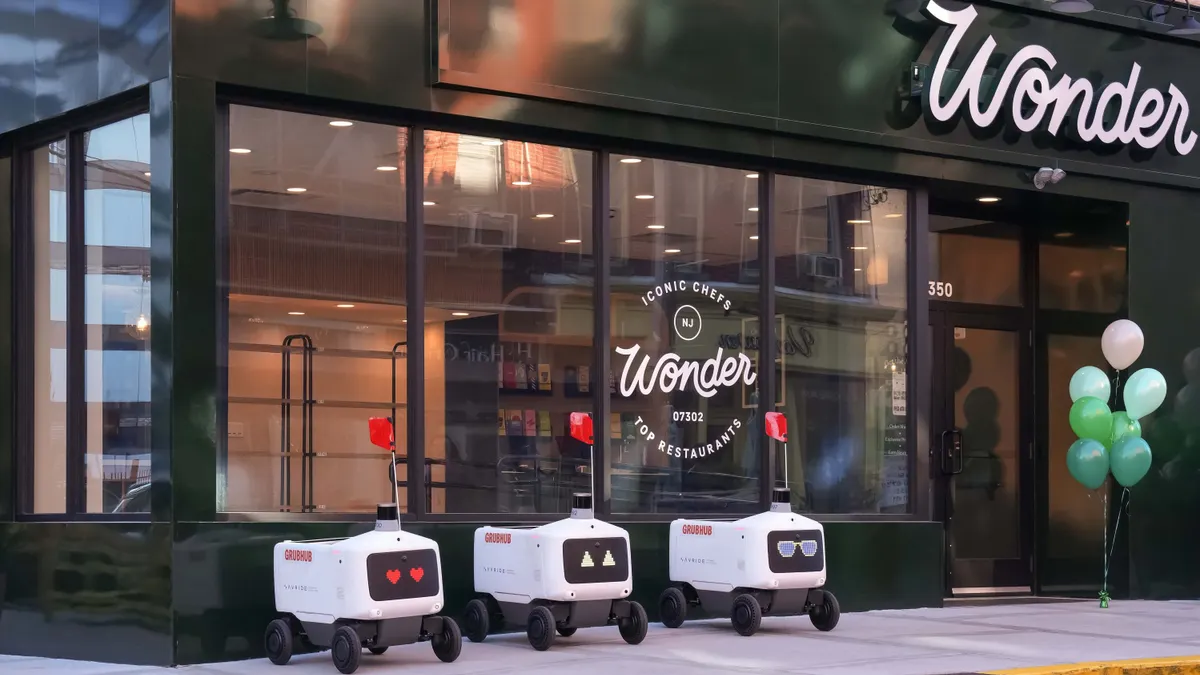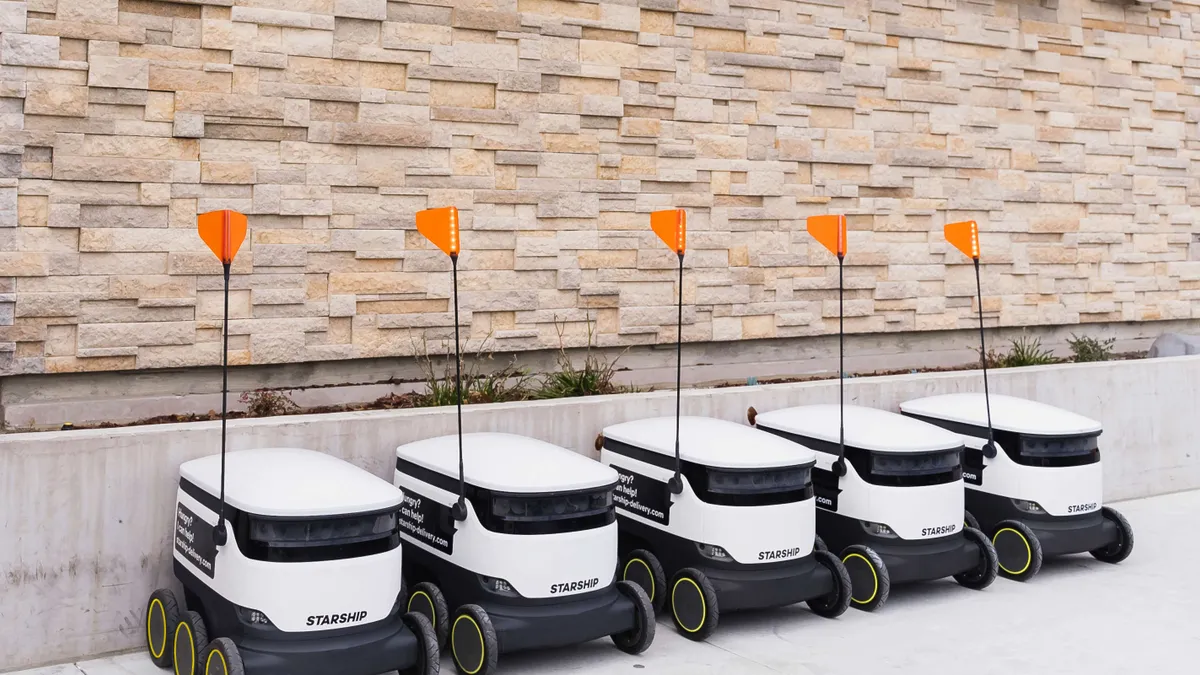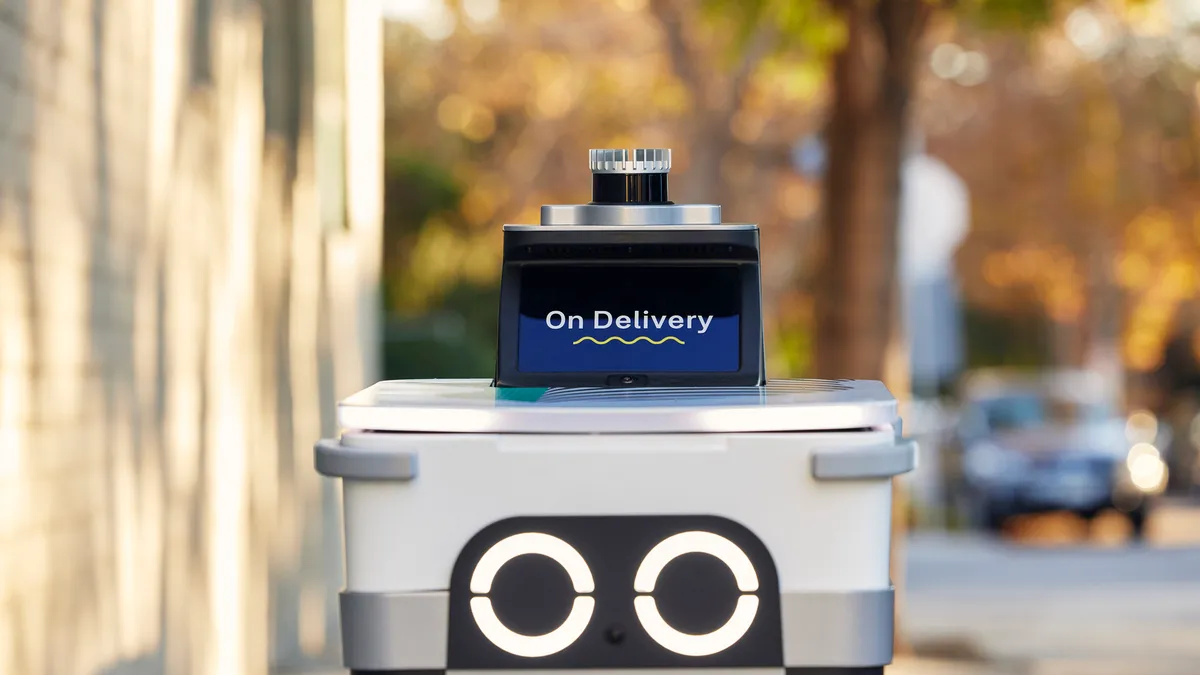Grubhub is determined to regain its delivery dominance, and though it made sizable gains in Q4, its path to growth is riddled with controversy.
The delivery company doubled its restaurant count during the period to 300,000 by adding 150,000 non-partnered restaurants and 15,000 partnered brands, according to a letter to shareholders.
This growth was a major milestone for the brand and came well ahead of its goal of doubling its restaurant count by the end of 2020, the letter revealed. The quarter brought thousands of new partnered locations with enterprise restaurants including Applebee's, Dunkin', McDonald’s, Popeyes, Shake Shack and Wendy's and regional chains like Round Table Pizza and honeygrow. It also signed up five independent or small or regional chains for every QSR location that it added in Q4, Adam DeWitt, Grubhub president and CFO, told investors during an earnings call on Thursday. But the company's biggest push targeted restaurants that had not agreed to join its network.
These non-partnered restaurants are driving orders from new and existing diners, orders that could have otherwise been lost to a competitor if it didn’t have that restaurant mix, the company said in the shareholder letter.
"If we have a loyal Grubhub diner looking to order from their local favorite that's not on Grubhub, … we have that option for them on Grubhub, even if it's a little bit more expensive," DeWitt told investors the earnings call.
But it may be too soon to tell whether this strategy is effective. As the company expected, diners pay higher fees for these orders since Grubhub doesn't collect a restaurant commission, resulting in a lower conversion rate among customers. These restaurants made up a low-single digit percentage of orders, according to the shareholder letter.
Its strategy to add restaurants has been met with growing resistance as well, and many non-partnered restaurants are pushing back against being listed. Restaurants have written negative reactions on social media about how their restaurants were posted without their consent and some have said they don’t even offer takeout, let alone delivery. Grubhub's integrative partnership with Yelp, where customers can order delivery from Yelp restaurant pages, also brought Yelp into the restaurant discord, and both removed non-partner delivery capabilities from the pages earlier this week, according to Grubhub.
"We've been very sensitive to the idea that you put a non-partnered restaurant on a platform, and maybe either the restaurant says, well, this is a good relationship as there is [or] we don't want to partner. Or it frustrates them and they don't want a partner," Grubhub CEO Matt Maloney said during the call.
DoorDash and Postmates have also received complaints in recent years over wrong menu items and food quality that restaurant operators can’t easily address. DoorDash faced a handful of lawsuits in the past, including one from In-N-Out in 2015 claiming the provider was damaging its brand by offering delivery.
It’s interesting to note, however, that DoorDash's non-partnered restaurant listings haven’t garnered the same level of scrutiny, over the past year, Hetal Pandya, Edison Trends founder, told Restaurant Dive. DoorDash has instead been on the hook for problems with its tipping policy, she said.
It is possible that discord among restaurants could wane this year, especially as more platforms add non-partnered restaurants to their platforms. Uber Eats has also begun pursuing non-partner restaurants to drive growth without pushback, and will continue to build this volume this year, Uber's CFO Nelson Chai said during the company's Q4 earnings call.
"The experience for the [non-partner] restaurant and for the diner is not as good as a partnered experience."

Matt Maloney
Grubhub CEO
"Our non-partner volume for Eats is very, very small as a percentage of our overall volume. This is a new feature that the team built out really in Q4," Chai said. "We're being careful in rolling out the feature because we want to make sure the delivery times, the delivery qualities continue to be at the levels of excellence that we insist on."
But by and large adding these non-partnered restaurants hasn't had much of an impact on Grubhub's ability to sell partnered restaurants to the platform, Maloney said. These restaurants also get some volume, but not as much volume as a partner restaurant, Maloney said. What often happens, he said, is that non-partnered restaurants want to see what volume would be like as a partner and end up signing on to an official partnership with Grubhub.
"The experience for the [non-partner] restaurant and for the diner is not as good as a partnered experience," he said.
Grubhub tried this non-partner strategy in the past, but found it resulted in slower deliveries and poorer quality of service, but the prevalence of the practice with competitors forced its hand back into it.
Even with its past experience and backlash from the independent restaurant community, Grubhub is bullish on its non-partner strategy's potential.
"The more supply we have, the more likely we are to gain the new diners, the more likely we are to retain diners. We’ve closed that supply gap really aggressively," Maloney said.
An uphill battle
Despite its efforts, market share eroded slightly since September, according to Edison Trends data emailed to Restaurant Dive. Based on a review of 150,000 transactions, both Uber Eats and Postmates grew in terms of total consumer spend in January compared to September, reaching 28.8% and 9.6%, respectively, while DoorDash maintained 35% market share. Grubhub, on the other hand, decreased slightly to 21.7% of consumer spend in January compared to 23.5% in September.
But since the reduction was only slight; Grubhub basically held its ground, Pandya said. Grubhub did report an increase in active diners, growing 28% to 22.6 million in 2019 compared to 17.7 million in 2018, according to its earnings release. Daily Average Grubs, which are the number of orders placed by customers, also increased during the year by 13% to 492,300 compared to 435,900 in 2018.
"I think they have done well this quarter," Pandya said. "I think the fourth quarter [is] where all of these companies grow quite a bit overall because delivery is higher during that time because of the holidays."
However, she said she thinks Grubhub slipped because its core strategies around restaurants, customer loyalty and customer spend on an average order are probably not growing as fast as other platforms.
"There is no loyalty in the customer base. They're just floating around from one platform to the next to get the best deal out there. That shows that the loyalty part hurts the market share for Grubhub and the market shrinked for them."

Hetal Pandya
Edison Trends founder
"Customers are getting so smart around these coupons and not having to pay delivery fees and all that stuff," Pandya said. "I think that that’s what is happening. There is no loyalty in the customer base. They're just floating around from one platform to the next to get the best deal out there. That shows that the loyalty part hurts the market share for Grubhub and the market shrinked for them."
The company has also been distracted by ongoing issues, including lawsuits and local government scrutiny over how it handles phone order charges. The company has since changed its policy, allowing restaurants more time to look back and contest phone charges.
It’s also struggling with some trust issues with restaurants, Pandya said.
Increasingly aggressive growth strategies at DoorDash and Uber Eats are also creating a tough environment for Grubhub. Executives said during a call with investors that they were expecting its initiatives to work over time so it may take a few quarters to see a meaningful impact on customer loyalty and market share, but that certainly hasn’t stopped it from rolling out new strategies.
New subscription service, pickup offering additional opportunities
Grubhub’s growth tactics stretch beyond non-partner restaurants, however. The company has been testing a diner subscription service in a few markets, which executives said could be ready within the next few months. Other delivery providers like DoorDash and Uber Eats already offer subscription programs.
Grubhub is also trying different pricing methods, so an offering in one market may be different in another, Maloney told investors. In addition, it’s measuring the impact on conversion and diner frequency. He expects it will take a few months to nail down the subscription model before a nationwide rollout.
Another big focus will be a program focused on pickup to build up another area of off-premise. In January, it launched a pickup platform called Ultimate with hundreds of partner restaurants and 20 university campuses, and it’s already receiving a lot of potential interest, executives said. The company is already talking to potential partners and is figuring out the best way to deploy Ultimate by geography.
"We believe that pickup could be the next major supply-side innovation to unlock accelerated growth in our industry," Maloney said in the shareholder letter.
The platform includes a kitchen display system, real-time order tracking across multiple channels, self-order kiosks and POS integration.
"Even in the homegrown QSR platforms for pre-order, you don't have transparency into who's in line in front of you," Maloney said. "You kind of have to go to the mosh pit in front of the pickup area and wait around until they call your name."
Maloney said this isn't a standard POS integration software like Olo and offers a basic POS system with functionality like clock-in, cash drawer and menu management, but doesn’t have a full suite of POS functions.
"It opens up a new demand gen[eration] opportunity for us," DeWitt said. "We're able to bring new diners to those restaurants."
Building diner loyalty
After bringing on more diners, the company will focus on retention, particularly with its loyalty program. The company is building up its Perks program, which combines restaurant loyalty programs into one platform or offers restaurants a way to build their own. Grubhub added 20 QSR loyalty programs to its Perks platform and diners have already redeemed millions of dollars during the fourth quarter, Maloney said.
"Early feedback on these programs has been positive from the brands, with higher order frequency and higher average order sizes," Maloney said in a letter to shareholders.
The company also recently started offering the program to independent restaurants on its platform and believe it could provide additional value as a Grubhub partner, the letter said. Hundreds of restaurants signed up in a matter of weeks, Maloney told investors.
"Perks is clearly making restaurants more competitive on our platform," he said.
Grubhub wants to quadruple the amount of rewards and offers available on its platform, he said.
"We want to make it the place to go to find all the rewards, [and] all the offers possible," Maloney said.
He said the company expects it will take three to six months to build up the independent restaurant side for loyalty while enterprise partners have been interested in increasing business through the platform.
Ultimately, all of these options are aimed to put Grubhub in a more aggressive position across multiple off-premise channels.
"You see diners sampling multiple platforms, so we want to make sure that we're as aggressive as possible stealing and maintaining that share," Maloney said.
Correction: A previous version of this article incorrectly stated the timeline of Yelp and Grubhub's removal of delivery capabilities from Yelp restaurant pages. These links were removed earlier this week.

















